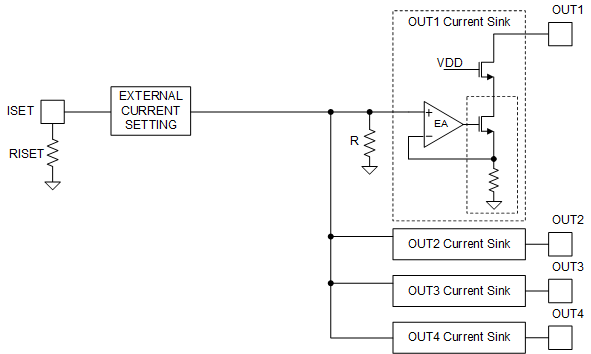JAJSKE2 March 2021 TPS92390
PRODUCTION DATA
- 1 特長
- 2 アプリケーション
- 3 概要
- 4 Revision History
- 5 Pin Configuration and Functions
- 6 Specifications
-
7 Detailed Description
- 7.1 Overview
- 7.2 Functional Block Diagram
- 7.3
Feature Description
- 7.3.1 Control Interface
- 7.3.2 Function Setting
- 7.3.3 Device Supply (VDD)
- 7.3.4 Enable (EN)
- 7.3.5 Charge Pump
- 7.3.6 Boost Controller
- 7.3.7 LED Current Sinks
- 7.3.8 Brightness Control
- 7.3.9
Protection and Fault Detections
- 7.3.9.1 Supply Faults
- 7.3.9.2
Boost Faults
- 7.3.9.2.1 Boost Overvoltage Faults (BSTOVPL, BSTOVPH)
- 7.3.9.2.2 Boost Overcurrent Faults (BSTOCP)
- 7.3.9.2.3 LEDSET Resistor Missing Faults (LEDSET)
- 7.3.9.2.4 MODE Resistor Missing Faults (MODESEL)
- 7.3.9.2.5 FSET Resistor Missing Faults (FSET)
- 7.3.9.2.6 ISET Resistor Out of Range Faults (ISET)
- 7.3.9.2.7 Thermal Shutdown Faults (TSD)
- 7.3.9.3 LED Faults
- 7.3.9.4 Overview of the Fault and Protection Schemes
- 7.4 Device Functional Modes
- 7.5 Programming
- 7.6 Register Maps
-
8 Application and Implementation
- 8.1 Application Information
- 8.2
Typical Applications
- 8.2.1
Full Feature Application for Display Backlight
- 8.2.1.1 Design Requirements
- 8.2.1.2
Detailed Design Procedure
- 8.2.1.2.1 Inductor Selection
- 8.2.1.2.2 Output Capacitor Selection
- 8.2.1.2.3 Input Capacitor Selection
- 8.2.1.2.4 Charge Pump Output Capacitor
- 8.2.1.2.5 Charge Pump Flying Capacitor
- 8.2.1.2.6 Output Diode
- 8.2.1.2.7 Switching FET
- 8.2.1.2.8 Boost Sense Resistor
- 8.2.1.2.9 Power-Line FET
- 8.2.1.2.10 Input Current Sense Resistor
- 8.2.1.2.11 Feedback Resistor Divider
- 8.2.1.2.12 Critical Components for Design
- 8.2.1.3 Application Curves
- 8.2.2 Application With Basic/Minimal Operation
- 8.2.3
SEPIC Mode Application
- 8.2.3.1 Design Requirements
- 8.2.3.2
Detailed Design Procedure
- 8.2.3.2.1 Inductor Selection
- 8.2.3.2.2 Coupling Capacitor Selection
- 8.2.3.2.3 Output Capacitor Selection
- 8.2.3.2.4 Input Capacitor Selection
- 8.2.3.2.5 Charge Pump Output Capacitor
- 8.2.3.2.6 Charge Pump Flying Capacitor
- 8.2.3.2.7 Switching FET
- 8.2.3.2.8 Output Diode
- 8.2.3.2.9 Switching Sense Resistor
- 8.2.3.2.10 Power-Line FET
- 8.2.3.2.11 Input Current Sense Resistor
- 8.2.3.2.12 Feedback Resistor Divider
- 8.2.3.2.13 Critical Components for Design
- 8.2.3.3 Application Curves
- 8.2.1
Full Feature Application for Display Backlight
- 9 Power Supply Recommendations
- 10Layout
- 11Device and Documentation Support
- 12Mechanical, Packaging, and Orderable Information
7.3.7.1 LED Output Current Setting
The maximum output LED current is set by an external resistor value. For the application only using external resistor RISET to set the maximum LED current for each string, the Equation 14 is used to calculate the current setting of all strings:

The LEDx_CURRENT[11:0] registers can also be used to adjust strings current down from this maximum. The default value for LEDx_CURRENT[11:0] registers is the maximum 0xFFF(4095). Equation 15 is used to calculate the current setting of an individual string:

For high accuracy of LED current, the ILED current is recommended to set in range from 30 mA to 200 mA. So the RISET value is in the range from 15.6 kΩ to 104 kΩ.
 Figure 7-8 LED
Driver Current Setting Circuit
Figure 7-8 LED
Driver Current Setting Circuit